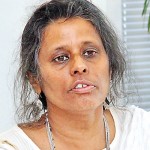Sunday Times 2
Anne Frank House exhibition in Sri Lanka
The story of the teenaged Jewish girl who kept a diary of her life in hiding during the Nazi occupation of the Netherlands during World War II has fascinated readers for decades. Just like ‘The Diary of a Young Girl’, the Anne Frank House exhibition has kept her memory alive, having travelled to 80 countries. Today this exhibition is in Sri Lanka.

Priya Machado. Pix by Indika Handuwala
“We are generally invited by those interested in having the exhibition displayed in their countries,” Loes Singels of the Anne Frank House explains. Following a request from Ambassador of Sri Lanka to The Hague, Buddhi Athauda, and with the Embassy of the Netherlands in Colombo funding the exhibition here, it became a reality.
With a successful pilot project in India, the team feels confident that their efforts will be well received in Sri Lanka as well. “The overall reaction to the exhibition in any country has been positive,” says Aron Peterer. Also a part of the Anne Frank House team, his role in the exhibition is one of the reasons setting it apart from others. Not only do the exhibits provoke introspection, he says they also open up a means of dialogue between participants.
“We try to keep the exhibition guides close to Anne’s age,” he explains. Interestingly, these guides are not from the Netherlands. Choosing children from the area, “Ideally of high school level” Aron has two days to train them to walk visitors through the life of Anne Frank.
In Sri Lanka, the Ministry of Education is to provide children to be trained as peer-guides.The exhibition is to be in Sinhalese, Tamil and English

Aron Peterer
and will remain in the country even after being displayed. With the intention of making it available to regions outside Colombo in the future the team says that any interested party, like schools, could request it to be set up in their area. “It will only be a matter or logistics.”
Priya Machado also with the Anne Frank House, found that when the exhibition was set-up in Kolkata, the peer-guides gained a “sense of pride in being able to show what they learned.” Heartened that the students were connecting Anne’s experience to their own local issues, she has similar hopes of the Sri Lankan students. What should ideally happen, she says is that students should add on to the exhibition with their story.
This, for Deputy Ambassador of the Netherlands, Lianne Houben is the one of the best aspects of Anne Frank’s story. She feels “there are parallels” given Sri Lanka’s history and many young people although not driven to hiding for two years may relate to some of Anne’s thoughts. “There were a lot of wounds in her time, and there are a lot of wounds in Sri Lanka now.”
The exhibition “Anne Frank- A History for Today” will be held at the Goethe Institute from January 28- February 1. Entrance is free.

